Characterization of Electrosynthesized Conjugated Polymer-Carbon Nanotube Composite: Optical Nonlinearity and Electrical Property
Abstract
:1. Introduction
2. Experimental Details
3. Results and Discussion
3.1. Morphology
3.2. Optical Measurements
3.3. Conductivity Studies
4. Conclusions
References
- MacDiarmid, A.G. “Synthetic metals”: A novel role for organic polymers (Nobel lecture). Angew. Chem. Int. Ed 2001, 40, 2581–2590. [Google Scholar]
- Skotheim, T.A. Handbook of Conducting Polymers; Marcel Dekker: New York, NY, USA, 1986; Volume 1. [Google Scholar]
- Alizadeh, N.; Khodaei-Tazekendi, H. Linear alkylbenzenesulfonate (LAS) ion-selective electrode based on electrochemically prepared polypyrrole and PVC. Sens. Actuator B. Chem 2001, 75, 5–10. [Google Scholar]
- Lin, C.W.; Hwang, B.J.; Lee, C.R. Methanol sensors based on the conductive polymer composites from polypyrrole and poly (vinyl alcohol). Mater. Chem. Phys 1998, 55, 139–144. [Google Scholar]
- Ding, H.; Ram, M.K. Applications of ordered ultrathin conducting polymeric films of polypyrrole. Supramol. Eng. Cond. Mater 2005, 199–231. [Google Scholar]
- Tieke, B.; Gabriel, W. Conducting polypyrrole-polyimide composite films. Polymer 1990, 31, 20–23. [Google Scholar]
- Pruneanu, S.; Resel, R.; Leising, G.; Brie, M.; Graupner, W.; Oniciu, L. Structural investigations on polypyrrole and poly(vinyl chloride)-polypyrrole composite films. Mater. Chem. Phys 1997, 48, 240–245. [Google Scholar]
- Ajayan, P.M.; Stephan, O.; Colliex, C.; Trauth, D. Aligned carbon nanotube arrays formed by cutting a polymer resin-nanotube composite. Science 1994, 265, 1212–1214. [Google Scholar]
- Baughman, R.H.; Zakhidov, A.A.; de Heer, W.A. Carbon nanotubes—The route toward applications. Science 2002, 297, 787–792. [Google Scholar]
- Dai, L.; Mau, A.W.H. Controlled synthesis and modification of carbon nanotubes and C60: Carbon nanostructures for advanced polymeric composite materials. Adv. Mater 2001, 13, 899–913. [Google Scholar]
- Rezaul Karim, M.; Lee, C.J.; Sarwaruddin Chowdhury, A.M.; Nahar, N.; Lee, M.S. Radiolytic synthesis of conducting polypyrrole/carbon nanotube composites. Mater. Lett 2007, 61, 1688–1692. [Google Scholar]
- Joo, J.; Kim, B.H.; Park, D.H.; Kim, H.S.; Seo, D.S.; Shim, J.H.; Lee, S.J.; Ryu, K.S.; Kim, K.; Jin, J.I.; Lee, T.J.; Lee, C.J. Fabrication and applications of conducting polymer nanotube, nanowire, nanohole, and double wall nanotube. Synth. Metals 2005, 153, 313–316. [Google Scholar]
- Wang, C.; Wang, Z.; Li, M.; Li, H. Well-aligned polyaniline nano-fibril array membrane and its field emission property. Chem. Phys. Lett 2001, 341, 431–434. [Google Scholar]
- Yu, Y.; Ouyang, C.; Gao, Y.; Si, Z.; Chen, W.; Wang, Z.; Xue, G. Synthesis and characterization of carbon nanotube/polypyrrole core–shell nanocomposites via in situ inverse microemulsion. J. Polym. Sci. Part A–Polym. Chem 2005, 43, 6105–6115. [Google Scholar]
- Alexandrou, I.; Kymakis, E.; Amaratunga, G.A.J. Polymer-nanotube composites: Burying nanotubes improves their field emission properties. Appl. Phys. Lett 2002, 80, 1435–1437. [Google Scholar]
- Shi, D.; Lian, J.; He, P.; Wang, L.M.; Xiao, F.; Yang, L.; Schulz, M.J.; Mast, D.B. Plasma coating of carbon nanofibers for enhanced dispersion and interfacial bonding in polymer composites. Appl. Phys. Lett 2003, 83, 5301–5303. [Google Scholar]
- Lau, K.T. Interfacial bonding characteristics of nanotube/polymer composites. Chem. Phys. Lett 2003, 370, 399–405. [Google Scholar]
- Yang, G.; Guan, D.; Wang, W.; Wu, W.; Chen, Z. The inherent optical nonlinearities of thin silver films. Opt. Mater 2004, 25, 439–443. [Google Scholar]
- He, T.; Cai, Z.; Li, P.; Cheng, Y.; Mo, Y. Third-order nonlinear response of Ag/methyl orange composite thin films. J. Mod. Opt 2008, 55, 975–983. [Google Scholar]
- Wang, J.; Xu, Y.; Chen, X.; Sun, X. Capacitance properties of single wall carbon nanotube/polypyrrole composite films. Compos. Sci. Technol 2007, 67, 2981–2985. [Google Scholar]
- Brânzoi, V.; Pilan, L.; Brânzoi, F. Nanocomposite films obtained by electrochemical codeposition of conducting polymers and carbon nanotubes. Electroanalysis 2009, 21, 557–562. [Google Scholar]
- Islam, M.F.; Rojas, E.; Bergey, D.M.; Johnson, A.T.; Yodh, A.G. High weight fraction surfactant solubilization of single-wall carbon nanotubes in water. Nano Lett 2003, 3, 269–273. [Google Scholar]
- Zhang, M.; Yan, Y.; Gong, K.; Mao, L.; Guo, Z.; Chen, Y. Electrostatic layer-by-layer assembled carbon nanotube multilayer film and its electrocatalytic activity for O2 reduction. Langmuir 2004, 20, 8781–8785. [Google Scholar]
- Zhang, X.; Zhang, J.; Wang, R.; Liu, Z. Cationic surfactant directed polyaniline/CNT nanocables: Synthesis, characterization, and enhanced electrical properties. Carbon 2004, 42, 1455–1461. [Google Scholar]
- Zhang, X.; Zhang, J.; Wang, R.; Zhu, T.; Liu, Z. Surfactant-directed polypyrrole/cnt nanocables: Synthesis, characterization, and enhanced electrical properties. Chem. Phys. Chem 2004, 5, 998–1002. [Google Scholar]
- Sheik-Bahae, M.; Said, A.A.; Van Stryland, E.W. High-sensitivity, single-beam n2 measurements. Opt. Lett 1989, 14, 95–957. [Google Scholar]
- Sheik-Bahae, M.; Said, A.A.; Wei, T.H.; Hagan, D.J.; Van Stryland, E.W. Sensitive measurement of optical nonlinearities using a single beam. IEEE J. Quantum Electron 1990, 26, 760–769. [Google Scholar]
- Yang, G.; Wang, H.; Tan, G.; Jiang, A.; Zhou, Y.; Chen, Z. Rh:BaTiO3 thin films with large nonlinear optical properties. Appl. Opt 2002, 41, 1729–1732. [Google Scholar]
- Cassano, T.; Tommasi, R.; Ferrara, M.; Babudri, F.; Farinola, G.M.; Naso, F. Substituent-dependence of the optical nonlinearities in poly(2,5-dialkoxy-p-phenylenevinylene) polymers investigated by the Z-scan technique. Chem. Phys 2001, 272, 111–118. [Google Scholar]
- Zengin, H.; Zhou, W.; Jin, J.; Czerw, R.; Smith, D.W.; Echegoyen, L.; Carroll, D.L.; Foulger, S.H.; Ballato, J. Carbon nanotube doped polyaniline. Adv. Mater 2002, 14, 1480–1483. [Google Scholar]
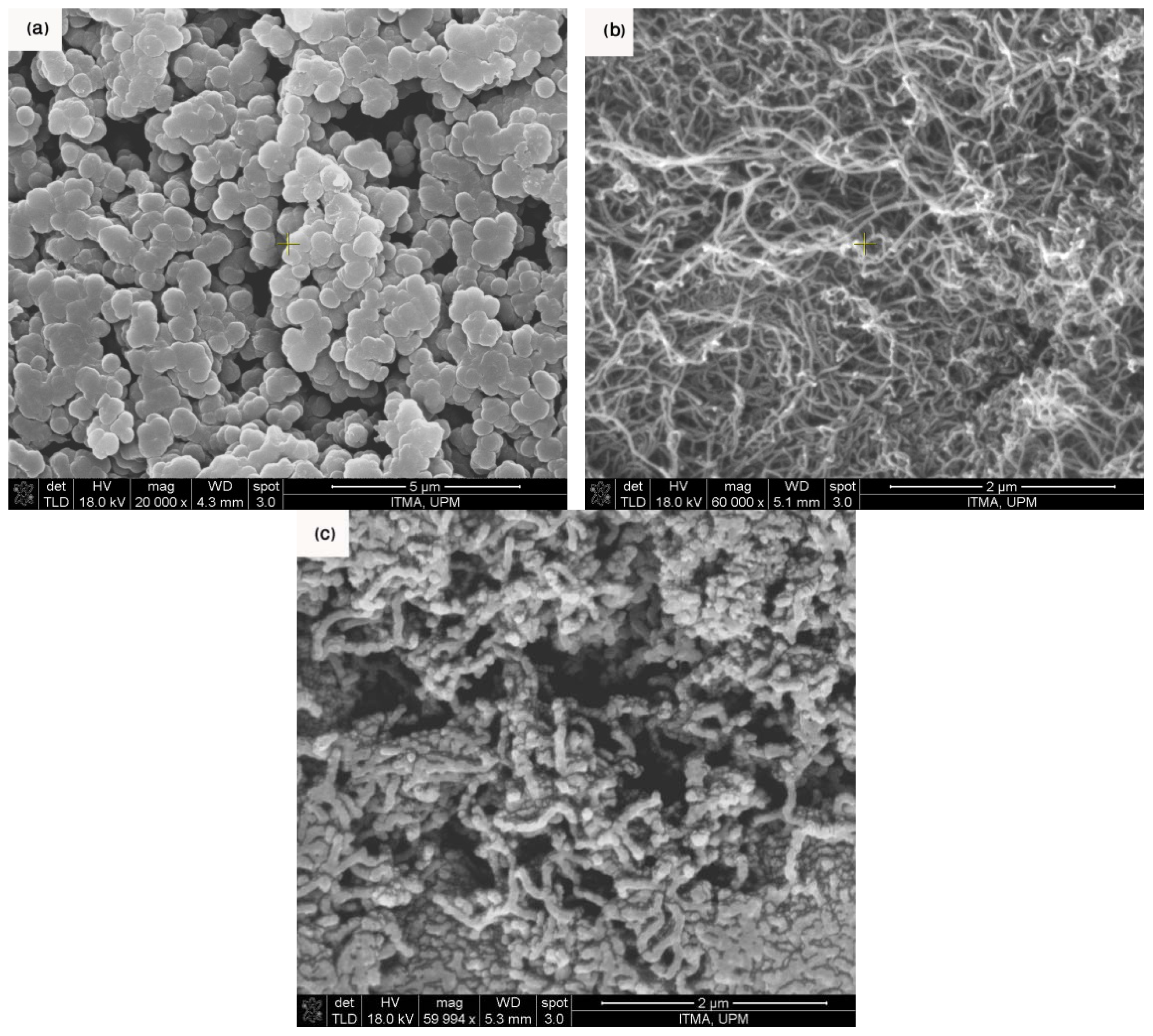
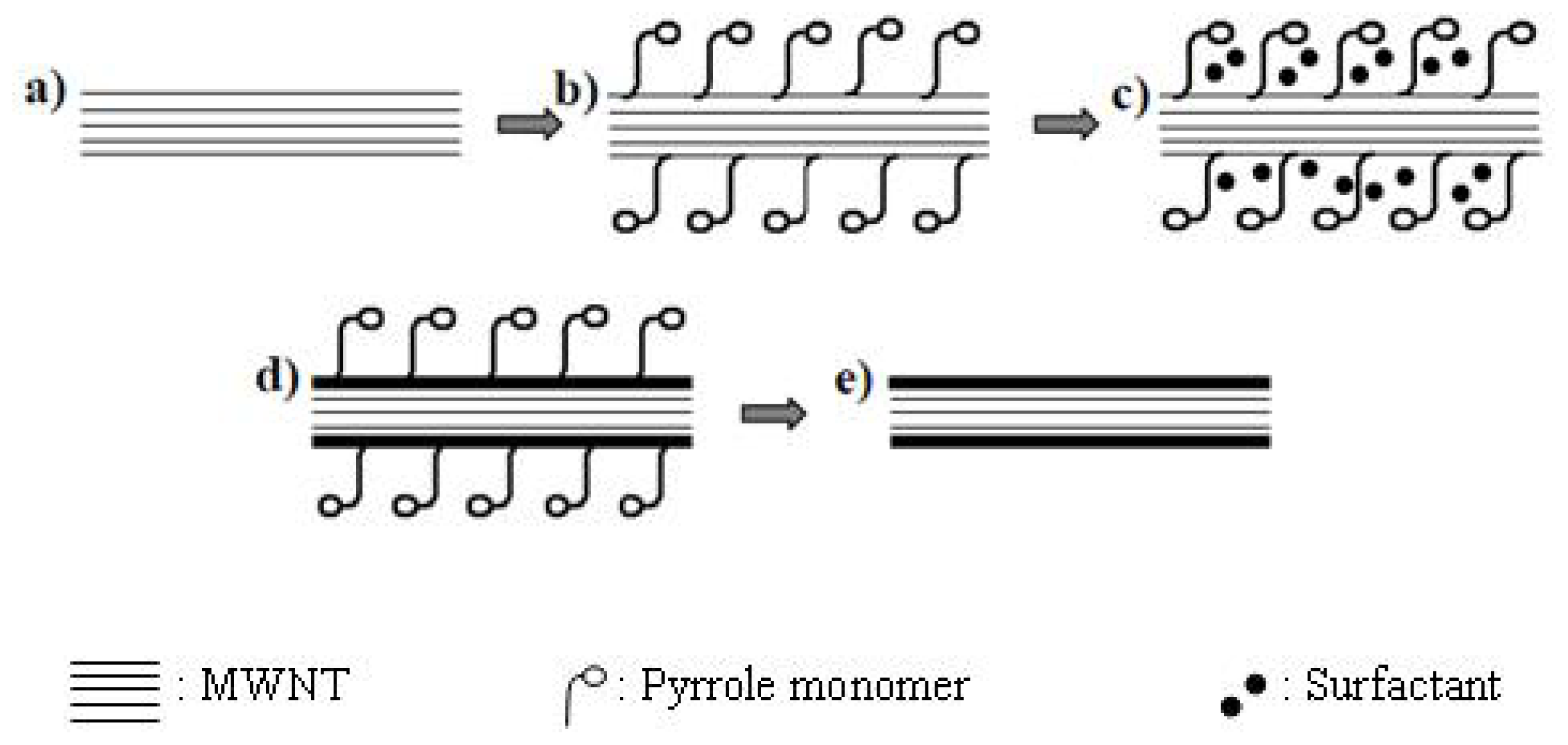
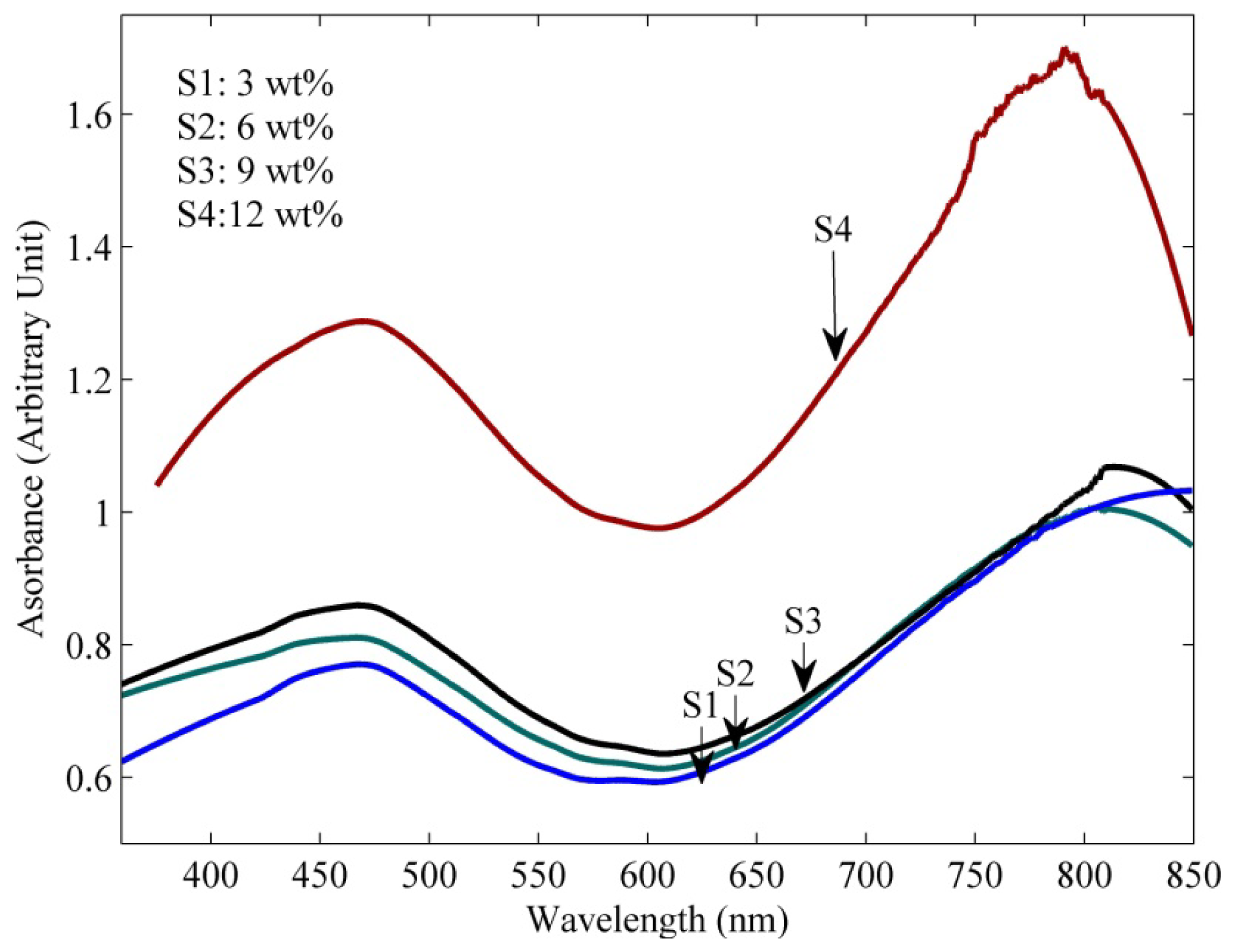
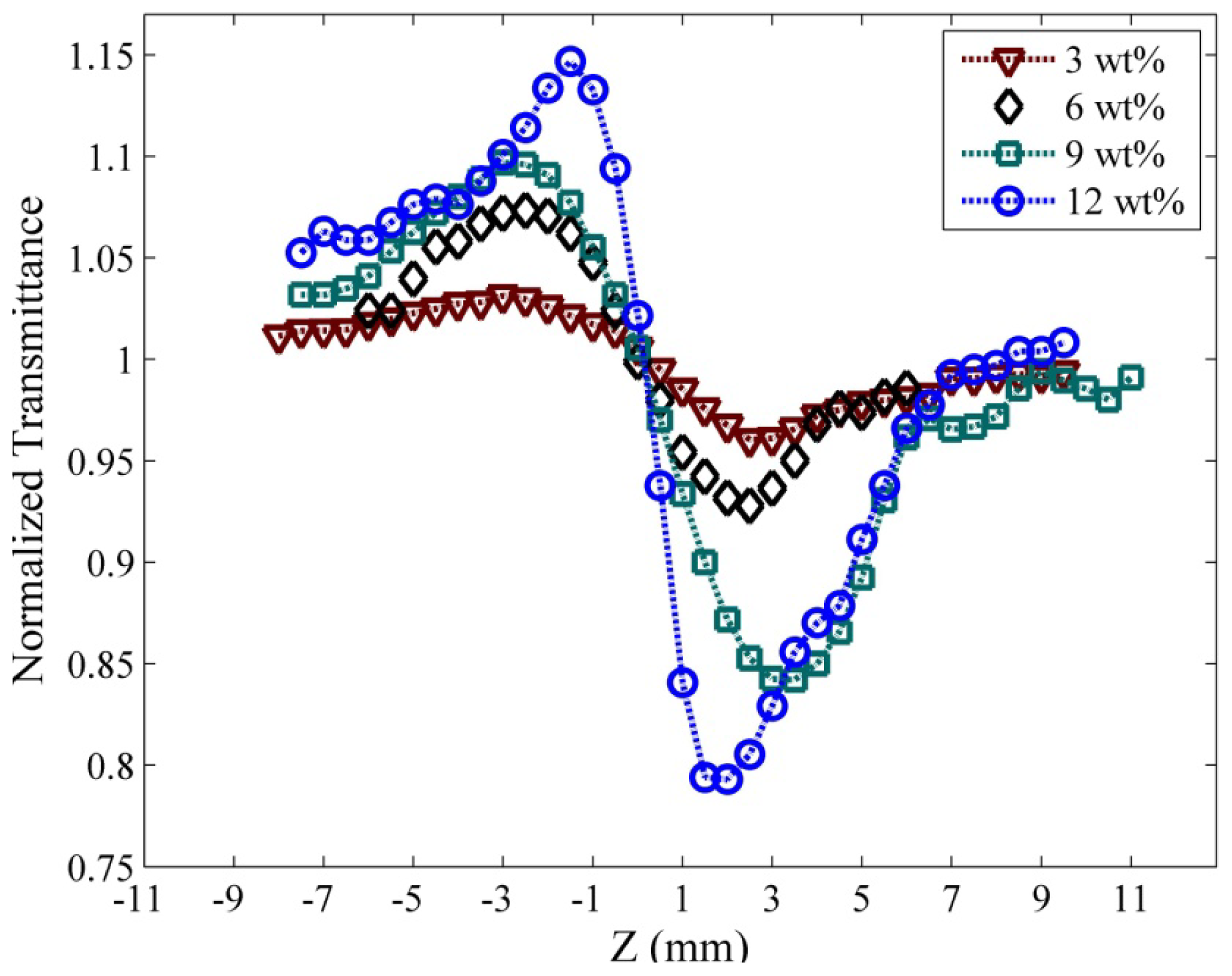
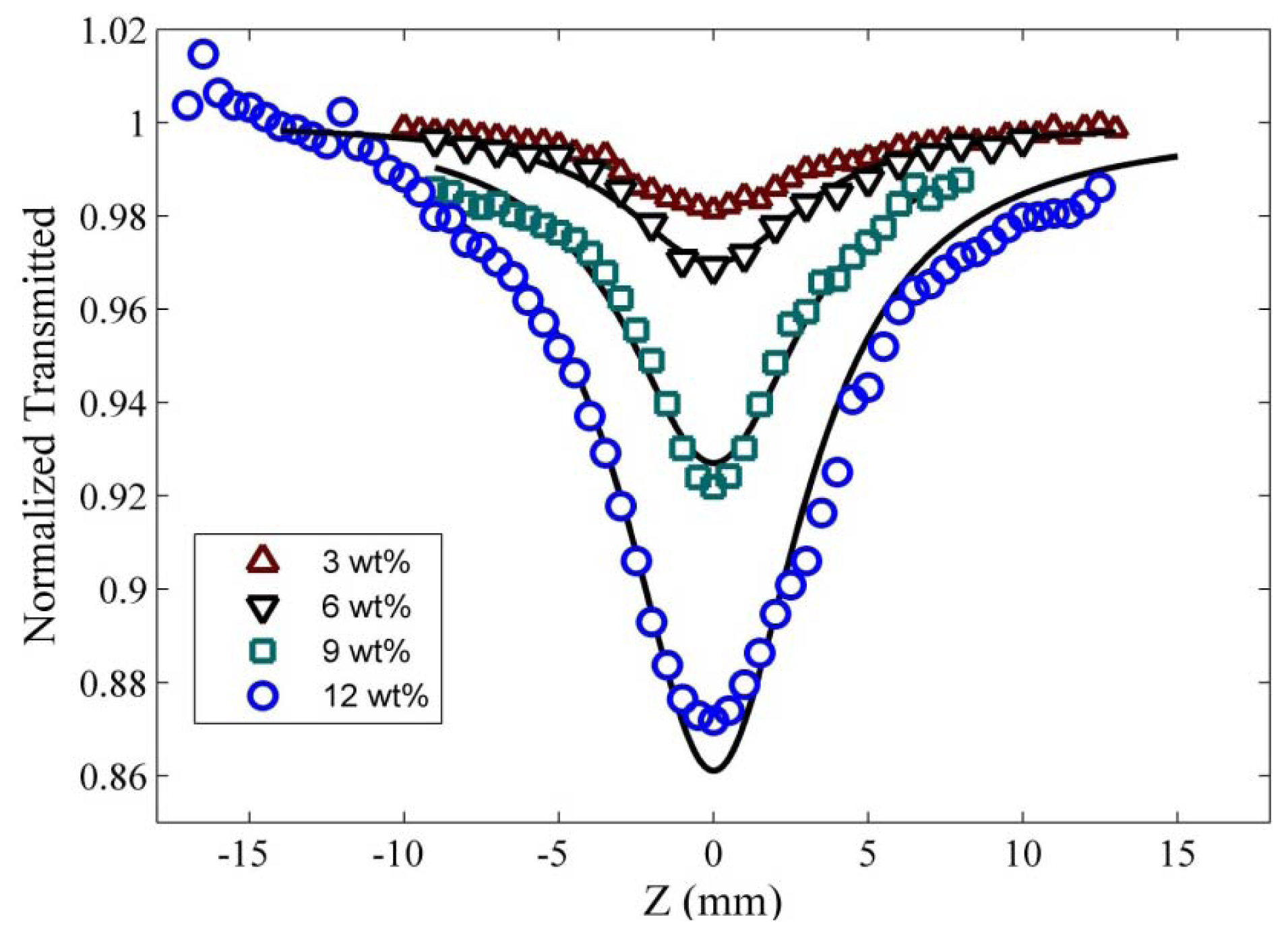
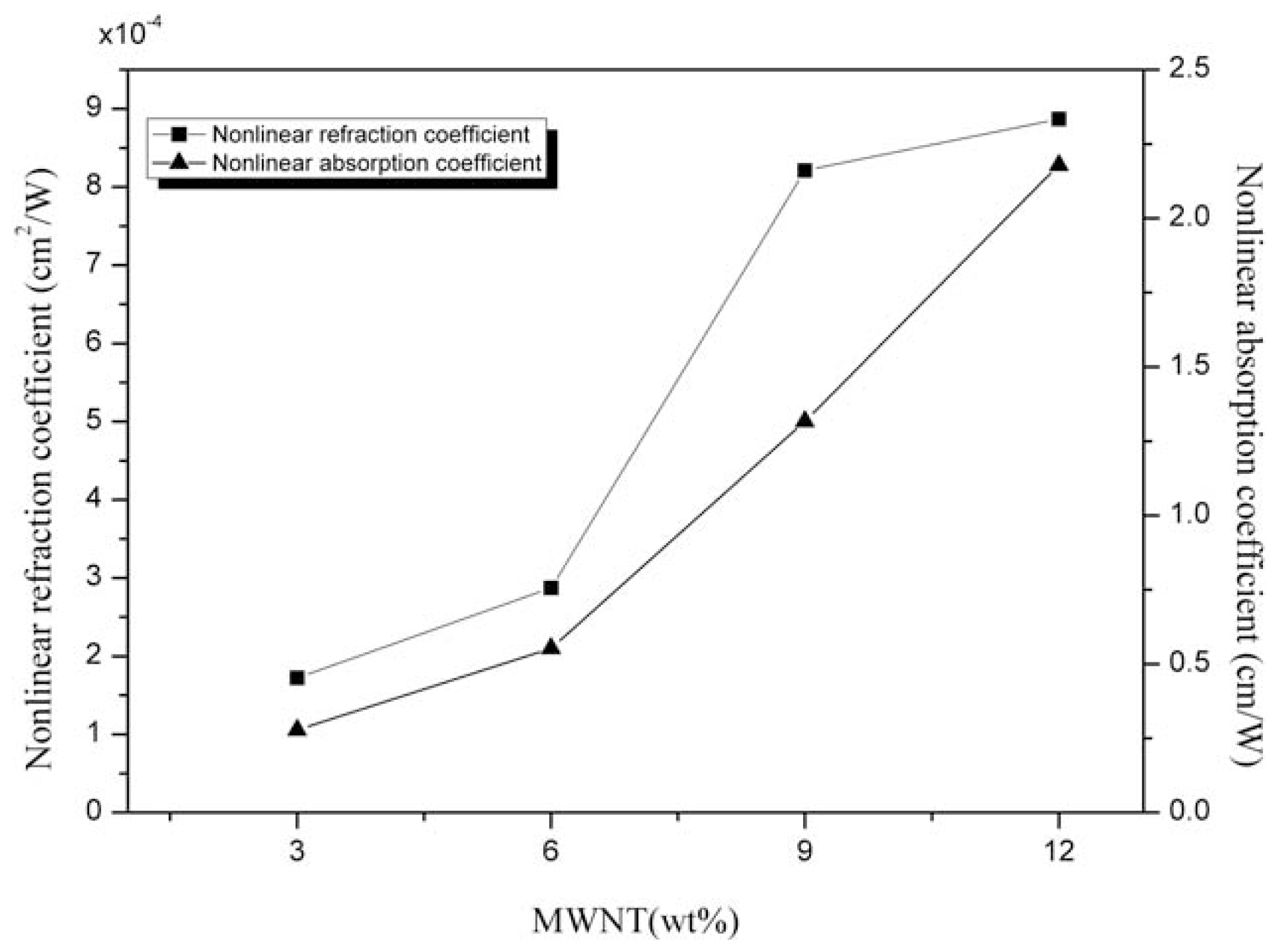
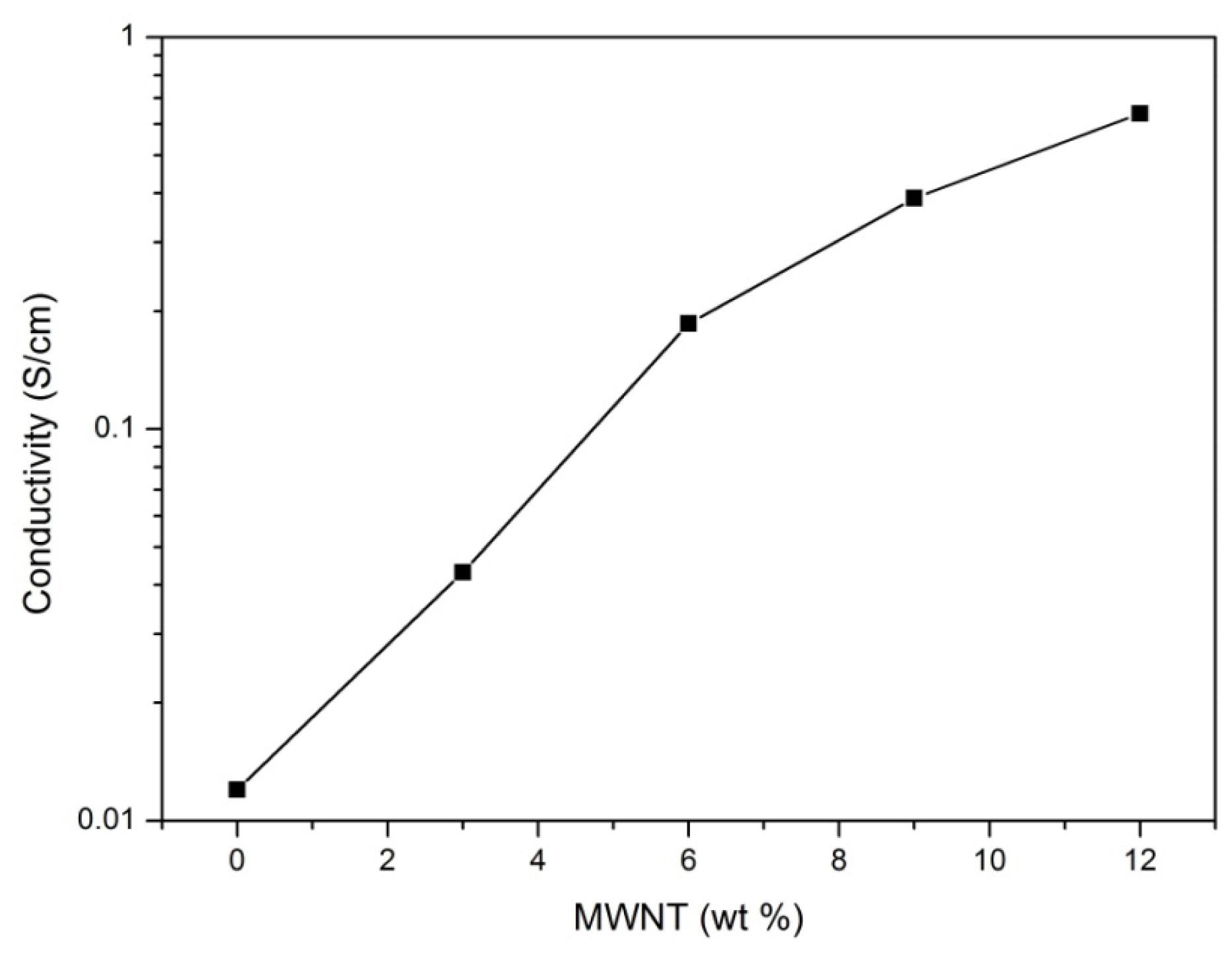
| Thin film samples | Concentration (wt %) | n2 (cm2/W) × 10−4 | β (2PA) (cm/W) | Re (χ(3)) × 10−4 | Im (χ(3)) × 10−4 | |χ(3)| × 10−4 |
|---|---|---|---|---|---|---|
| S1 | 3 | −1.721 | 0.278 | −85.461 | 0.5852 | 85.485 |
| S2 | 6 | −2.872 | 0.553 | −142.612 | 1.1640 | 142.614 |
| S3 | 9 | −8.211 | 1.317 | −407.951 | 2.769 | 407.959 |
| S4 | 12 | −8.872 | 2.179 | −440.750 | 4.582 | 440.776 |
© 2012 by the authors; licensee Molecular Diversity Preservation International, Basel, Switzerland. This article is an open-access article distributed under the terms and conditions of the Creative Commons Attribution license (http://creativecommons.org/licenses/by/3.0/).
Share and Cite
Bahrami, A.; Talib, Z.A.; Shahriari, E.; Yunus, W.M.M.; Kasim, A.; Behzad, K. Characterization of Electrosynthesized Conjugated Polymer-Carbon Nanotube Composite: Optical Nonlinearity and Electrical Property. Int. J. Mol. Sci. 2012, 13, 918-928. https://doi.org/10.3390/ijms13010918
Bahrami A, Talib ZA, Shahriari E, Yunus WMM, Kasim A, Behzad K. Characterization of Electrosynthesized Conjugated Polymer-Carbon Nanotube Composite: Optical Nonlinearity and Electrical Property. International Journal of Molecular Sciences. 2012; 13(1):918-928. https://doi.org/10.3390/ijms13010918
Chicago/Turabian StyleBahrami, Afarin, Zainal Abidin Talib, Esmaeil Shahriari, Wan Mahmood Mat Yunus, Anuar Kasim, and Kasra Behzad. 2012. "Characterization of Electrosynthesized Conjugated Polymer-Carbon Nanotube Composite: Optical Nonlinearity and Electrical Property" International Journal of Molecular Sciences 13, no. 1: 918-928. https://doi.org/10.3390/ijms13010918




